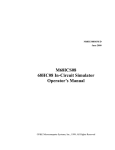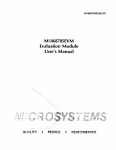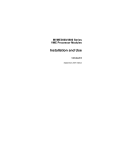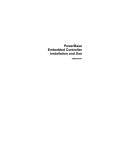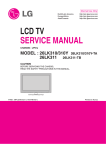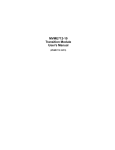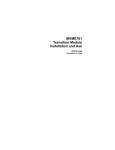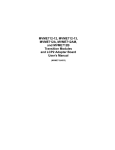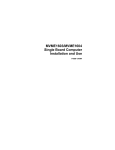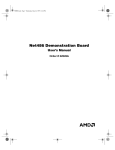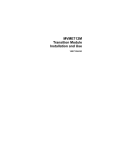Download MVME760 Transition Module User`s Manual
Transcript
MVME760 Transition Module User’s Manual VME760A/UM1 Notice While reasonable efforts have been made to assure the accuracy of this document, Motorola, Inc. assumes no liability resulting from any omissions in this document, or from the use of the information obtained therein. Motorola reserves the right to revise this document and to make changes from time to time in the content hereof without obligation of Motorola to notify any person of such revision or changes. No part of this material may be reproduced or copied in any tangible medium, or stored in a retrieval system, or transmitted in any form, or by any means, radio, electronic, mechanical, photocopying, recording or facsimile, or otherwise, without the prior written permission of Motorola, Inc. It is possible that this publication may contain reference to, or information about Motorola products (machines and programs), programming, or services that are not announced in your country. Such references or information must not be construed to mean that Motorola intends to announce such Motorola products, programming, or services in your country. Restricted Rights Legend If the documentation contained herein is supplied, directly or indirectly, to the U.S. Government, the following notice shall apply unless otherwise agreed to in writing by Motorola, Inc. Use, duplication, or disclosure by the Government is subject to restrictions as set forth in subparagraph (c)(1)(ii) of the Rights in Technical Data and Computer Software clause at DFARS 252.227-7013. Motorola, Inc. Computer Group 2900 South Diablo Way Tempe, Arizona 85282 Preface The MVME760 User’s Manual provides general information, hardware preparation, installation instructions and support information for the MVME760 Transition Module. The MVME760 module is used as the interface between host VMEmodules and various peripheral devices. A ribbon cable is used to connect the MVME760 Transition Module to the host VMEmodule. This manual is intended for anyone who wants to design OEM systems, supply additional capability to an existing compatible system, or for use in a lab environment for experimental purposes. A basic knowledge of computers and digital logic is assumed. To use this manual you should be familiar with the publications listed in the following section: Related Documentation. Related Documentation The Motorola publications listed below are referenced in this document. If not shipped with this product, manuals may be purchased by contacting your local Motorola sales office. Document Title Motorola Publication Number MVME1603/MVME1604 Single Board Computer Installation and Use V1600-1A/IH MVME1603/MVME1604 Single Board Computer Programmer’s V1600-1A/PG Reference Guide MVME1603/MVME1604 Support Information V1600-1A/SC PM603/PM604 Processor/Memory Mezzanine Module User’s Manual PM603A/UM PPCBug Debugging Package User’s Manual (Parts 1 and 2) PPCBUGA1/UM PPCBUGA2/UM PPC1Bug Diagnostics Manual PPC1DIAA/UM SIM705 Serial Interface Module Installation Guide SIM705A/IH Note Although not shown in the above list, each Motorola Computer Group manual publication number is suffixed with characters which represent the revision level of the document, such as “/ D2” (the second revision of a manual); a supplement bears the same number as the manual but has a suffix such as “/A1” (the first supplement to the manual). Motorola® and the Motorola symbol are registered trademarks of Motorola, Inc. AIX™ is a trademarks of IBM. PowerPC™ is a trademark of IBM, and is used by Motorola with permission. All other products mentioned in this document are trademarks or registered trademarks of their respective holders. © Copyright Motorola 1995 All Rights Reserved Printed in the United States of America January 1995 Safety Summary Safety Depends On You The following general safety precautions must be observed during all phases of operation, service, and repair of this equipment. Failure to comply with these precautions or with specific warnings elsewhere in this manual violates safety standards of design, manufacture, and intended use of the equipment. Motorola, Inc. assumes no liability for the customer's failure to comply with these requirements. The safety precautions listed below represent warnings of certain dangers of which Motorola is aware. You, as the user of the product, should follow these warnings and all other safety precautions necessary for the safe operation of the equipment in your operating environment. Ground the Instrument. To minimize shock hazard, the equipment chassis and enclosure must be connected to an electrical ground. The equipment is supplied with a three-conductor ac power cable. The power cable must either be plugged into an approved three-contact electrical outlet or used with a three-contact to two-contact adapter, with the grounding wire (green) firmly connected to an electrical ground (safety ground) at the power outlet. The power jack and mating plug of the power cable meet International Electrotechnical Commission (IEC) safety standards. Do Not Operate in an Explosive Atmosphere. Do not operate the equipment in the presence of flammable gases or fumes. Operation of any electrical equipment in such an environment constitutes a definite safety hazard. Keep Away From Live Circuits. Operating personnel must not remove equipment covers. Only Factory Authorized Service Personnel or other qualified maintenance personnel may remove equipment covers for internal subassembly or component replacement or any internal adjustment. Do not replace components with power cable connected. Under certain conditions, dangerous voltages may exist even with the power cable removed. To avoid injuries, always disconnect power and discharge circuits before touching them. Do Not Service or Adjust Alone. Do not attempt internal service or adjustment unless another person capable of rendering first aid and resuscitation is present. Use Caution When Exposing or Handling the CRT. Breakage of the Cathode-Ray Tube (CRT) causes a high-velocity scattering of glass fragments (implosion). To prevent CRT implosion, avoid rough handling or jarring of the equipment. Handling of the CRT should be done only by qualified maintenance personnel using approved safety mask and gloves. Do Not Substitute Parts or Modify Equipment. Because of the danger of introducing additional hazards, do not install substitute parts or perform any unauthorized modification of the equipment. Contact your local Motorola representative for service and repair to ensure that safety features are maintained. Dangerous Procedure Warnings. Warnings, such as the example below, precede potentially dangerous procedures throughout this manual. Instructions contained in the warnings must be followed. You should also employ all other safety precautions which you deem necessary for the operation of the equipment in your operating environment. ! WARNING Dangerous voltages, capable of causing death, are present in this equipment. Use extreme caution when handling, testing, and adjusting. ! WARNING This equipment generates, uses, and can radiate electromagnetic energy. It may cause or be susceptible to electromagnetic interference (EMI) if not installed and used in a cabinet with adequate EMI protection. Contents CHAPTER 1 General Information Introduction ..................................................................................................................... 1-1 Features of the MVME760 Module ........................................................................... 1-1 Specifications ................................................................................................................... 1-2 Cooling Requirements .................................................................................................. 1-2 FCC Compliance............................................................................................................. 1-3 General Description ....................................................................................................... 1-3 CHAPTER 2 Hardware Preparation and Installation Introduction ..................................................................................................................... 2-1 Unpacking Instruction .................................................................................................. 2-1 MVME760 Module Preparation ................................................................................. 2-1 Configuring Serial Ports 3 and 4................................................................................ 2-4 Installation Instructions................................................................................................ 2-5 CHAPTER 3 Support Information Introduction ..................................................................................................................... 3-1 COM1 and COM2 Serial Ports ................................................................................... 3-3 Serial Ports 3 and 4......................................................................................................... 3-5 P2 Connector.................................................................................................................. 3-10 Ethernet (AUI and 10BaseT) Connectors .............................................................. 3-14 IEEE P1284 Parallel I/O Connector ........................................................................ 3-15 COM1 and COM2 Connectors ................................................................................. 3-16 Serial Port 3 Connectors ............................................................................................. 3-17 Serial Port 4 Connector ............................................................................................... 3-19 Serial I/O Data Rate .................................................................................................... 3-20 Ethernet Data Rate ....................................................................................................... 3-20 Parts Lists and Locations ........................................................................................... 3-20 Schematic Drawings .................................................................................................... 3-24 vii INDEX Index ....................................................................................................................IN-1 viii List of Figures Figure 2-1. Figure 2-2. Figure 2-3. Figure 3-1. Figure 3-2. Figure 3-3. Figure 3-4. Figure 3-5. Figure 3-6. Figure 3-7. MVME760 Connector Locations.................................................... 2-2 MVME760 Header Locations......................................................... 2-3 MVME760 Cable Connections ....................................................... 2-6 MVME760 Transition Module Block Diagram ............................ 3-2 COM1 and COM2 Configurations ................................................ 3-4 Ports 3/4 in EIA-232 DCE Configuration .................................... 3-6 Ports 3/4 in EIA-232 DTE Configuration..................................... 3-7 Ports 3/4 in EIA-530 DCE Configuration .................................... 3-8 Ports 3/4 in EIA-530 DTE Configuration..................................... 3-9 MVME760 Parts Location Drawing ............................................ 3-23 ix x List of Tables Table 1-1. MVME760 Specifications................................................................... 1-2 Table 1-2. Module Type Identification............................................................... 1-4 Table 3-1. Connector P2 Interconnect Signals (MVME760).......................... 3-10 Table 3-2. AUI Connector Pin Assignments (MVME760) ............................ 3-14 Table 3-3. 10BaseT Connector Pin Assignments ............................................ 3-15 Table 3-4. Parallel I/O Connector Signals (MVME760)................................ 3-15 Table 3-5. COM1 and COM2 Interconnect Signals (MVME760) ................. 3-16 Table 3-6. Pin Assignments for Serial Port 3 Connectors ............................. 3-18 Table 3-7. Serial Port 4 Interconnections ......................................................... 3-19 Table 3-8. MVME760 Module Parts List.......................................................... 3-20 xi xii 1General Information 1 Introduction This manual provides general information, hardware preparation, installation instructions, and support information for the MVME760 Transition Module. The MVME760 module is used as the interface between host VMEmodules and various peripheral devices. A 64-pin ribbon cable (P/N 30-W2514B02, 17” length) connects the MVME760 Transition Module to the host VMEmodule. Features of the MVME760 Module The features of the MVME760 module include industry-standard connectors that interface to: ❏ Two EIA-232 asynchronous serial ports ❏ Two synchronous serial ports ❏ One parallel port (IEEE Standard 1284-I compliant) ❏ Ethernet interface (both AUI and 10BaseT) ❏ Two 60-pin connectors are provided to support existing MCG Serial Interface Modules. Currently, there are four types of SIMs available: EIA-232 DCE, EIA-232 DTE, EIA-530 DCE, and EIA-530 DTE. The selection of these modules determines the functionality of the two synchronous serial ports. 1-1 1 Specifications Specifications The MVME760 module specifications are shown in Table 1-1. Table 1-1. MVME760 Specifications Characteristics Power Requirements I/O Port Connectors Serial Parallel Ethernet Operating temperature Storage temperature Relative Humidity Physical characteristics (excluding front panel) Specifications + 5Vdc, 1A maximum (500 mA typical) +12Vdc, 100mA (w/o LAN transceiver) -12Vdc, 100mA Two EIA-232 async serial ports Two synchronous serial ports One IEEE Std 1284-I compliant parallel port One AUI and One 10BaseT 0 degrees to 55 degrees C at point of entry of forced air (approximately 5 CFM) -40 degrees to 85 degrees C 5% to 90% (non-condensing) Height 9.187 inches(233.35 mm) Depth 3.200 inches(80.00 mm) Thickness 0.063 inches (1.60 mm) Cooling Requirements The MVME760 module has minimal active circuitry. In general, convection cooling will suffice. However, care must be taken such that other system components or other external sources of heat do not cause the actual operating temperature to exceed the specified operating temperature. 1-2 General Information FCC Compliance The MVME760 module was tested in an FCC-compliant chassis, and meets the requirements for Class A equipment. FCC compliance was achieved under the following conditions: 1. Shielded cables on all external I/O ports. 2. Cable shields connected to earth ground via metal shell connectors bonded to a conductive module front panel. 3. Conductive chassis rails connected to earth ground. This provides the path for connecting shields to earth ground. 4. Front panel screws properly tightened. For minimum RF emissions, it is essential that the conditions above be implemented; failure to do so could compromise the FCC compliance of the equipment containing the modules. General Description The MVME760 Transition Module provides the interface between standard Ethernet, Parallel Port, and the Serial Port connectors and the Host board P2 connector. The Ethernet and Parallel Ports contain passive circuitry only. The I/O controllers themselves reside in the host board. The Serial Ports contain active circuitry, to provide multiplexing and buffering functions (reference Figure 3-1, MVME760 Transition Module Block Diagram). The multiplexing function is transparent to the user. Two 60-pin headers are provided to support existing MCG Serial Interface Modules. Currently, there are four types of Serial Interface modules available as shown in Table 1-2: 1-3 1 1 General Description Table 1-2. Module Type Identification Model Number 1-4 Module Type Part Number SIM705-001 EIA-232 DCE 01-W3876Bxx SIM705-002 EIA-232 DTE 01-W3877Bxx SIM705-003 EIA-530 DCE 01-W3878Bxx SIM705-004 EIA-530 DTE 01-W3879Bxx 2Hardware Preparation and Installation 2 Introduction This chapter provides unpacking instructions, hardware preparation, and installation instructions for the MVME760 module. Unpacking Instruction Note If the carton is damaged upon receipt, request that the carrier’s agent be present during unpacking and inspection of the equipment. Unpack the equipment from the shipping carton. Refer to the packing list and verify that all items are present. Save the packing material for storing and reshipping of the equipment. MVME760 Module Preparation No preparation is necessary if Serial ports 3 and 4 are not used. However, to ensure full functionality of Serial Port 3 and Serial Port 4, the MVME760 Transition Module must be properly configured. Configuration is accomplished through jumper settings and SIM module population options. The MVME760 connectors and header locations are illustrated in Figure 2-1 and Figure 2-2. Note that Serial Port 3 is available at J7, as well as at J5 on the front panel. Serial Port 4 is available only via the J2 header 2-1 MVME760 Module Preparation 2 BASE BOARD TRANSITION MODULE COM1 P1 COM2 SERIAL PORT 3 64-PIN 50-MIL CABLE P2 P2 PARALLEL PORT AUI 10BASET 1544 9410 Figure 2-1. MVME760 Connector Locations 2-2 Hardware Preparation and Installation 2 SERIAL PORT 4 MVME 760-001 COM1 J1 COM2 J3 J2 SIM MODULE (PORT 4) J7 SIM MODULE (PORT 3) SERIAL PORT 3 SERIAL 3 J8 J5 3 DCE DTE 1 3 DCE PARALLEL J10 ETHERNET J11 DTE 1 J9 F1 P2 1.1A. POLYSWITCH 10BASET J12 1545 9410 Figure 2-2. MVME760 Header Locations 2-3 Configuring Serial Ports 3 and 4 Configuring Serial Ports 3 and 4 2 Headers J9 and J8 are used to configure Serial Port 3 and Serial Port 4, respectively. When the jumper is in position 1-2, the port is configured as a DTE. When the jumper is in position 2-3, the port is configured as a DCE. The jumper setting must match the corresponding SIM module controlling that port (DTE or DCE). When installing the SIM modules, note the headers are keyed for proper orientation. J9 J9 Serial Port 3 jumper settings 1 2 3 1 2 DTE DCE J8 J8 3 Serial Port 4 jumper settings 1 2-4 2 DTE 3 1 2 DCE 3 15446 9410 Hardware Preparation and Installation Installation Instructions 2 The basic procedure for installation of the MVME760 module is as follows: 1. Turn all equipment power OFF and disconnect the power cable from the AC power source. ! Connecting modules while the power is applied may result in damage to components on the module. Caution ! Warning Dangerous voltages, capable of causing death, are present in this equipment. Use extreme caution when handling, testing, and adjusting. 2. Remove the chassis cover as instructed in the equipment user’s manual. 3. Remove the filler panel(s) from the appropriate card slot(s) at the rear of the chassis (if the chassis has a rear card cage). Other modules in the unit may have to be moved to allow space for the cables connected to the MVME760 module. 4. Install SIM modules for Serial Ports 3 and 4 (see Figure 2-2 for location of SIMs). 5. Install MVME760 module in rear card cage. 6. Attach the flat ribbon cable supplied with the MVME760 module from P2 on the host board to P2 on the Transition Module. Be sure to orient cable pin 1 with connector pin 1 (See Figure 2-3). 7. After making sure you will not pinch cables with the cover, reinstall the cover you previously removed. 8. Connect the power cable to the AC power source and turn on the unit. 2-5 Installation Instructions 2 MVME760 J1 HOST J3 J5 P1 J10 1 J11 P2 1 J12 P2 P2 ENCLOSURE BOUNDARY 1548 9412 Figure 2-3. MVME760 Cable Connections 2-6 3Support Information 3 Introduction This chapter provides the interconnection signals, parts lists, parts location illustrations, and schematic diagrams for the MVME760 Transition Module. The block diagram for the MVME760 Transition Module is shown in Figure 3-1. 3-1 10BaseT AUI PARALLEL COM1 COM2 SERIAL 3 RJ45 DB15 HD36 DB9 DB9 HD26 26-PIN 3M SERIAL 3 SERIAL 4 26-PIN 3M BUFFERS EIA-232 BUFFERS EIA-232 P2MX FUNCTION CONNECTOR TO SERIAL MODULE 3 CONNECTOR TO SERIAL MODULE Support Information 64-PIN DIN CONNECTOR 1549 9410 Figure 3-1. MVME760 Transition Module Block Diagram 3-2 COM1 and COM2 Serial Ports COM1 and COM2 Serial Ports COM1 and COM2 are the two asynchronous serial ports. These two ports are configured as shown in Figure 3-2. 3-3 3 Support Information 3 TXD1 C19 3 RTS1_ A20 7 DTR1_ C20 4 RXD1 A17 2 CTS1_ C17 8 DSR1_ A18 6 DCD1_ C18 1 RI1_ A19 9 COM1 5 P2 TXD2 C24 3 RTS2_ A24 7 DTR2_ C25 4 RXD2 A21 2 CTS2_ C22 8 DSR2_ A22 6 DCD2_ C23 1 RI2_ A23 9 COM2 5 BASE BOARD MVME760 1550 9410 Figure 3-2. COM1 and COM2 Configurations 3-4 Serial Ports 3 and 4 Serial Ports 3 and 4 Serial Ports 3 and 4 can be individually configured as EIA-232-D DCE, EIA-232-D DTE, EIA-530 DCE, or EIA-530 DTE by installing the appropriate Serial Interface Module. Figure 3-3 and Figure 3-4 show the configuration diagrams for Serial Ports 3 and 4 with the EIA-232 DCE and EIA-232 DTE Serial Interface Modules. Figure 35 and 3-6 show the configuration diagrams for Serial Ports 3 and 4 with the EIA-530 DCE and EIA-530 DTE Serial Interface Modules. 3-5 3 Support Information Z85230 SCC P2/P2MX 3M DB25 (Port 3 only) TXD 5 3 RXD RTS_ 9 5 CTS RXD 3 2 TXD CTS_ 7 4 RTS DCD_ 14 20 DTR 3 4 15 TXCI 2 1 8 17 RXCI 22 24 TXCO DTR_ 15 8 DCD LLB_ 24 25 TM RLB_ 18 22 RI DSR_ 11 6 DSR RI_ 16 21 RLB TM_ 10 18 LLB 13 7 GND 3 TRXC J9, J8 RTXC Z8536 CIO EIA232-DCE SIM 1554 9411 Figure 3-3. Ports 3/4 in EIA-232 DCE Configuration 3-6 Serial Ports 3 and 4 Z85230 SCC P2/P2MX 3M DB25 (Port 3 only) TXD 3 2 TXD RTS_ 7 4 RTS RXD 5 3 RXD CTS_ 9 5 CTS DCD_ 15 8 DCD 3 22 24 TXCO 2 1 4 15 TXCI 8 17 RXCI DTR_ 14 20 DTR LLB_ 10 18 LLB RLB_ 16 21 RLB DSR_ 11 6 DSR RI_ 18 22 RI TM_ 24 25 TM 13 7 GND TRXC J9, J8 RTXC Z8536 CIO EIA232-DTE SIM 1555 9411 Figure 3-4. Ports 3/4 in EIA-232 DTE Configuration 3-7 3 Support Information Z85230 SIM08 EIA-530 DCE P2/P2MX FRONT PANEL DB25 (Port 3 only) 3M PORTS 3, 4 3 NC TXD 2 D 3 6 5 R RXD RTS_ 12 D 7 25 CTS _ R PIN 1 1 9 20 14 TXD_B TXD_A RXD_B RXD_A PIN 14 PIN 2 PIN 16 PIN 3 RTS_B RTS_A CTS_B CTS_A PIN 19 PIN 4 PIN 13 PIN 5 DTR_B DTR_A PIN 23 PIN 20 R DCD_ DSR_B D 18 11 DSR_A PIN 22 PIN 6 TXC_B J9, J8 +5V 1 TRXC D 23 4 TXC_A PIN 12 PIN 15 RXC_B 2 D 17 8 3 RXC_A PIN 9 PIN 17 TXCO_B R RTXC 21 22 +5V 24 D TXCO_A TM_A PIN 11 PIN 24 PIN 25 LL_A 10 NC 16 PIN 21 13 PIN 7 RL_A Z8536 CIO DTR_ PIN 18 NC D 10 DCB_B DCD_A 15 PIN 10 PIN 8 1557 9412 Figure 3-5. Ports 3/4 in EIA-530 DCE Configuration 3-8 Serial Ports 3 and 4 Z85230 SIM08 EIA-530 DTE P2/P2MX FRONT PANEL DB25 (Port 3 only) 3M PORTS 3, 4 NC 3 PIN 1 1 TXD_B TXD 2 D TXD_A PIN 2 3 RXD 6 5 R RTS_ 12 D 7 25 CTS _ R 9 RXD_B RXD_A PIN 16 PIN 3 RTS_B RTS_A PIN 19 PIN 4 CTS_B PIN 13 CTS_A PIN 5 DCD_B 19 15 R DCD_ PIN 14 DCD_A PIN 10 PIN 8 DSR_B 18 11 R NC J9, J8 1 DSR_A PIN 22 PIN 6 TXC_B 23 4 R +5V TXC_A PIN 12 PIN 15 RXC_B 2 17 8 R TRXC RXC_A PIN 9 PIN 17 TXCO_B 21 22 D 3 RTXC NC 24 TXCO_A TM_A PIN 11 PIN 24 PIN 25 LL_A +5V D PIN 18 10 RL_A D +5V Z8536 CIO DTR_ D 16 PIN 21 13 PIN 7 20 DTR_B DTR_A 14 PIN 23 PIN 20 1558 9412 Figure 3-6. Ports 3/4 in EIA-530 DTE Configuration 3-9 Support Information P2 Connector P2 is a 64-pin DIN connector providing power and signaling. The 64-pin ribbon cable P/N is 30-W2514B02. Table 3-1 shows the interconnect signals. Note Row B is not populated. Power distribution and signaling are accomplished using rows A and C only. 3 Table 3-1. Connector P2 Interconnect Signals (MVME760) Pin Number Signal Mnemonic Signal Name and Description P2 C1 C+ COLLISION + (Input) (Ethernet) - a signal to indicate that multiple stations are contending for access to the transmission medium. A1 CCOLLISION - (Input) (Ethernet) - part of a differential pair. C2 T+ TRANSMIT + (Output) (Ethernet) - this line is intended to operate into terminated transmission lines. A2 TTRANSMIT - (Output) (Ethernet) - part of a differential pair. C3 R+ RECEIVE + (Input) (Ethernet) - a data input sourced by the MAU. A3 RRECEIVE - (Input) (Ethernet) - part of a differential pair. C4 RDRECEIVE DATA A4 RD+ RECEIVE DATA+ C5 TDTRANSMIT DATAA5 TD+ TRANSMIT DATA+ C6 +12V +12Vdc Power A6 PRD0 Refer to the IEEE P1284 D2.00 Standard C7 PRD1 Refer to the IEEE P1284 D2.00 Standard A7 PRD2 Refer to the IEEE P1284 D2.00 Standard C8 PRD3 Refer to the IEEE P1284 D2.00 Standard A8 PRD4 Refer to the IEEE P1284 D2.00 Standard C9 PRD5 Refer to the IEEE P1284 D2.00 Standard A9 PRD6 Refer to the IEEE P1284 D2.00 Standard C10 PRD7 Refer to the IEEE P1284 D2.00 Standard 3-10 P2 Connector Table 3-1. Connector P2 Interconnect Signals (MVME760) (Continued) Pin Number P2 A10 C11 A11 C12 A12 C13 A13 C14 A14 C15 A15 C16 A16 C17 GND PRSTB_ PRACK_ GND PRBSY PRPE PRSEL INPRIME_ PRFAULT_ SELIN_ AUTOFD_ +5V GND CTS1 SIGNAL GROUND Refer to the IEEE P1284 D2.00 Standard Refer to the IEEE P1284 D2.00 Standard SIGNAL GROUND Refer to the IEEE P1284 D2.00 Standard Refer to the IEEE P1284 D2.00 Standard Refer to the IEEE P1284 D2.00 Standard Refer to the IEEE P1284 D2.00 Standard Refer to the IEEE P1284 D2.00 Standard Refer to the IEEE P1284 D2.00 Standard Refer to the IEEE P1284 D2.00 Standard +5Vdc Power SIGNAL GROUND CLEAR TO SEND (serial port 1) - CTS is a function supplied to the terminal by the modem, and indicates that it is permissible to begin transmission of a message. When using a modem, CTS follows the off-to-on transition of RTS after a time delay. A17 RXD1 C18 DCD1 A18 DSR1 C19 TXD1 A19 RI1 RECEIVE DATA (serial port 1) - data that is demodulated from the receive line is presented to the terminal by the modem. DATA CARRIER DETECT (serial port 1) - sent by the modem to the terminal to indicate that a valid carrier is being received. DATA SET READY (serial port 1) - a function supplied by the modem to the terminal to indicate that the modem is ready to transmit data. TRANSMIT DATA (serial port 1) - data to be transmitted is furnished on this line to the modem from the terminal. RING INDICATOR (serial port 1) - Sent by the modem to the terminal indicating the ringing signal is present. Signal Mnemonic Signal Name and Description 3 3-11 Support Information Table 3-1. Connector P2 Interconnect Signals (MVME760) (Continued) 3 Pin Number Signal Mnemonic Signal Name and Description P2 C20 DTR1 DATA TERMINAL READY (serial port 1) - a signal from the terminal to the modem indicating that the terminal is ready to send or receive data. A20 RTS1 REQUEST TO SEND (serial port 1) - RTS is supplied by the terminal to the modem when it is required to transmit a message. With RTS off, the modem carrier remains off. When RTS is turned on, the modem immediately turns on the carrier. A21 RXD2 RECEIVE DATA (serial port 2) - data that is demodulated from the receive line is presented to the terminal by the modem. C21 GND SIGNAL GROUND C22 CTS2 CLEAR TO SEND (serial port 2) - CTS is a function supplied to the terminal by the modem, and indicates that it is permissible to begin transmission of a message. When using a modem, CTS follows the off-to-on transition of RTS after a time delay. A22 DSR2 DATA SET READY (serial port 2) - a function supplied by the modem to the terminal to indicate that the modem is ready to transmit data. C23 DCD2 DATA CARRIER DETECT (serial port 2) - sent by the modem to the terminal to indicate that a valid carrier is being received. A23 RI2 RING INDICATOR (serial port 2) - Sent by the modem to the terminal indicating the ringing signal is present. C24 TXD2 TRANSMIT DATA (serial port 2) - data to be transmitted is furnished on this line to the modem from the terminal. A24 RTS2 REQUEST TO SEND (serial port 2) - RTS is supplied by the terminal to the modem when it is required to transmit a message. With RTS off, the modem carrier remains off. When RTS is turned on, the modem immediately turns on the carrier. 3-12 P2 Connector Table 3-1. Connector P2 Interconnect Signals (MVME760) (Continued) Pin Number Signal Mnemonic Signal Name and Description P2 C25 DTR2 DATA TERMINAL READY (serial port 2) - a signal from the terminal to the modem indicating that the terminal is ready to send or receive data. A25 GND SIGNAL GROUND C26 RXD3 RECEIVE DATA (serial port 3) - data that is demodulated from the receive line is presented to the terminal by the modem. A26 RTXC3 RECEIVE CLOCK (serial port 3) - this line can be configured to clock input data from a terminal to a modem. C27 TXD3 TRANSMIT DATA (serial port 3) - data to be transmitted is furnished on this line to the modem from the terminal. A27 TRXC3 TRANSMIT CLOCK (serial port 3) - this line can be configured to clock output data to the modem from the terminal. C28 RXD4 RECEIVE DATA (serial port 4) - data that is demodulated from the receive line is presented to the terminal by the modem. A28 RTXC4 RECEIVE CLOCK (serial port 4) - this line can be configured to clock input data from a terminal to a modem. C29 TXD4 TRANSMIT DATA (serial port 4) - data to be transmitted is furnished on this line to the modem from the terminal. A29 TRXC4 TRANSMIT CLOCK (serial port 4) - this line can be configured to clock output data to the modem from the terminal. C30 -12V -12Vdc Power A30 MXDI C31 MXDO A31 C32 A32 MXSYNC_ GND MXCLK Serial MULTIPLEXER DATA IN - signal driven to the main board. Serial MULTIPLEXER DATA OUT - received from main board. MULTIPLEXER SYNC - Serial Multiplexer sync signal. SIGNAL GROUND MULTIPLEXER CLOCK - Serial Multiplexer clock signal. 3-13 3 Support Information Ethernet (AUI and 10BaseT) Connectors The MVME760 provides both AUI and 10BaseT interface via the front panel of the MVME760 transition module. The AUI interface and the 10BaseT interface are provided through a standard 2-row DB15 connector and an RJ45 connector respectively. 3 Each pin connection, signal mnemonic, and signal description for the AUI connector is listed in Table 3-2. The AUI connector shield is tied to chassis ground. Table 3-2. AUI Connector Pin Assignments (MVME760) Pin Number 1 2 3 4 5 6 7 8 9 10 11 12 13 14 15 3-14 Signal Mnemonic Signal Name and Description GND SIGNAL GROUND. C+ COLLISION + (Input) - a signal to indicate that multiple stations are contending for access to the transmission medium. T+ TRANSMIT + (Output) - this line is intended to operate into terminated transmission lines. GND SIGNAL GROUND. R+ RECEIVE + (Input) - a data input sourced by the MAU. GND SIGNAL GROUND. Not used. GND SIGNAL GROUND. CCOLLISION - (Input) - part of a differential pair. TTRANSMIT - (Output) - part of a differential pair. GND SIGNAL GROUND. RRECEIVE - (Input) - part of a differential pair. +12VF +12 Vdc Power -(1.1A Polyswitch) GND SIGNAL GROUND. Not used. IEEE P1284 Parallel I/O Connector Each pin connection, signal mnemonic, and signal description for the 10BaseT connector is listed in the following table. The 10BaseT connector shield is tied to chassis ground. 3 Table 3-3. 10BaseT Connector Pin Assignments Pin Number 1 2 3 4 5 6 7,8 Signal Mnemonic TD+ TDRD+ RD- Signal Name and Description Transmit Data+ Transmit DataRead Data+ Not used. Not used. Read DataNot used. IEEE P1284 Parallel I/O Connector The parallel I/O connector is a standard IEEE P1284-C, 36-pin receptacle on the MVME760 front panel. The functionality of each signal depends on the mode of operation of this bi-directional Parallel Peripheral Interface. Refer to the IEEE P1284 D2.00 Standard for a complete description of each signal function. The pin assignments for this connector are shown in the following table. The parallel port connector shield is tied to chassis ground. Table 3-4. Parallel I/O Connector Signals (MVME760) Pin Number 1 Signal Mnemonic PRBSY 2 3 4 5 PRSEL PRACK_ PRFAULT_ PRPE Signal Name and Description See IEEE P1284 D2.00 Standard for signal names and functionality. See IEEE P1284 D2.00 Standard See IEEE P1284 D2.00 Standard See IEEE P1284 D2.00 Standard See IEEE P1284 D2.00 Standard 3-15 Support Information Table 3-4. Parallel I/O Connector Signals (MVME760) (Continued) Pin Number 3 6 7 8 9 10 11 12 13 14 15 16 17 18 19-25 Signal Mnemonic PRD0 PRD1 PRD2 PRD3 PRD4 PRD5 PRD6 PRD7 INPRIME_ PRSTB_ SELIN_ AUTOFD_ +5V GND Signal Name and Description See IEEE P1284 D2.00 Standard See IEEE P1284 D2.00 Standard See IEEE P1284 D2.00 Standard See IEEE P1284 D2.00 Standard See IEEE P1284 D2.00 Standard See IEEE P1284 D2.00 Standard See IEEE P1284 D2.00 Standard See IEEE P1284 D2.00 Standard See IEEE P1284 D2.00 Standard See IEEE P1284 D2.00 Standard See IEEE P1284 D2.00 Standard See IEEE P1284 D2.00 Standard +5Vdc Power SIGNAL GROUND COM1 and COM2 Connectors Two standard DB9 connectors located on the front panel of the MVME760 transition module provide the interface to the COM1 and COM2 serial ports. The pin assignments for these connectors are shown in Table 3-5. The COM1 and COM2 connector shields are tied to chassis ground. Table 3-5. COM1 and COM2 Interconnect Signals (MVME760) Pin Number 1 3-16 Signal Mnemonic Signal Name and Description DCD DATA CARRIER DETECT - Sent by the modem to the terminal to indicate that a valid carrier is being received. Not used by port 1 (J1). Serial Port 3 Connectors Table 3-5. COM1 and COM2 Interconnect Signals (MVME760) (Continued) Pin Number 2 3 4 5 6 7 8 9 Signal Mnemonic Signal Name and Description RXD RECEIVE DATA - data that is demodulated from the receive line is presented to the terminal by the modem. TXD TRANSMIT DATA - data to be transmitted is furnished on this line to the modem from the terminal. DTR DATA TERMINAL READY - A signal from the terminal to the modem indicating that the terminal is ready to send or receive data. GND SIGNAL GROUND DSR DATA SET READY - DSR is a function supplied by the modem to the terminal to indicate that the modem is ready to transmit data. This signal can be held high or low through header J8, J9, J13, J14. RTS REQUEST TO SEND - RTS is supplied by the terminal to the modem when it is required to transmit a message. With RTS off, the modem carrier remains off. When RTS is turned on, the modem immediately turns on the carrier. CTS CLEAR TO SEND - CTS is a function supplied to the terminal by the modem, and indicates that it is permissible to begin transmission of a message. When using a modem, CTS follows the off-to-on transition of RTS after a time delay. RI RING INDICATOR - Sent by the modem to the terminal indicating the ringing signal is present. 3 Serial Port 3 Connectors Two connectors are provided for Serial Port 3: A 26-pin mini delta ribbon connector located on the front panel of the MVME760 transition module and a 26-pin ribbon-cable (3M-type) header located on the board itself. The pin assignments for these two connectors are shown in Table 3-6. The mini delta ribbon connector shield is tied to chassis ground. 3-17 Support Information Table 3-6. Pin Assignments for Serial Port 3 Connectors Front-panel Connector 3 Pin # 1 2 3 4 5 6 7 8 9 10 11 12 13 14 15 16 17 18 19 20 21 22 23 24 25 26 Signal Name No Connect TXD3 RXD3 RTS3 CTS3 DSR3 GND DCD3 SP3_P9 SP3_P10 SP3_P11 SP3_P12 SP3_P13 SP3_P14 TXCI3 SP3_P16 RXCI3 LLB3 SP3_P19 DTR3 RLB3 RI3 SP3_P23 TXCO3 TM3 No Connect Pin # 1 3 5 7 9 11 13 15 17 19 21 23 25 2 4 6 8 10 12 14 16 18 20 22 24 26 3m-Type Ribbon Connector Mated DB25 Signal Name Pin # No Connect 1 TXD3 2 RXD3 3 RTS3 4 CTS3 5 DSR3 6 GND 7 DCD3 8 SP3_P9 9 SP3_P10 10 SP3_P11 11 SP3_P12 12 SP3_P13 13 SP3_P14 14 TXCI3 15 SP3_P16 16 RXCI3 17 LLB3 18 SP3_P19 19 DTR3 20 RLB3 21 RI3 22 SP3_P23 23 TXCO3 24 TM3 25 No Connect Mated DB26 Pin # 1 2 3 4 5 6 7 8 9 10 11 12 13 14 15 16 17 18 19 20 21 22 23 24 25 26 NOTE: signal names indicate functionality when EIA-232 SIM module is installed. 3-18 Serial Port 4 Connector Serial Port 4 Connector A 26-pin ribbon-cable (3M-type) header provides the interface to Serial Port 4. Ribbon cable with mating connector can be used to interface to this header. The pin assignments for this connector are shown in the following table. This connector is not shielded. Table 3-7. Serial Port 4 Interconnections Ribbon Connector Pin # Signal Name 1 3 5 7 9 11 13 15 17 19 21 23 25 2 4 6 8 10 12 14 16 18 20 22 24 26 No Connect TXD4 RXD4 RTS4 CTS4 DSR4 GND DCD4 SP4_P9 SP4_P10 SP4_P11 SP4_P12 SP4_P13 SP4_P14 TXCI4 SP4_P16 RXCI4 LLB4 SP4_P19 DTR4 RLB4 RI4 SP4_P24 TXCO4 TM4 No Connect Mated DB25 Pin # 1 2 3 4 5 6 7 8 9 10 11 12 13 14 15 16 17 18 19 20 21 22 23 24 25 Mated DB26 Pin # 1 2 3 4 5 6 7 8 9 10 11 12 13 14 15 16 17 18 19 20 21 22 23 24 25 26 NOTE: Signal names indicate functionality when EIA-232 SIM module is installed. 3-19 3 Support Information Serial I/O Data Rate The serial data rate supported depends on the host board implementation. Refer to related documentation. 3 Ethernet Data Rate The Ethernet data rate supported depends on the host board implementation. Refer to related documentation. Parts Lists and Locations The following parts lists and parts location drawings reflect the latest issue of hardware at the time of printing. Parts lists are illustrated in Table 3-8. Parts locations are illustrated in Figure 3-7. Model MVME760 Parts List Table 3-8 Parts Location Drawing Figure 3-7 Table 3-8. MVME760 Module Parts List Reference Designation Motorola Part Number 84-W8000F01A CR1,CR2 48NW963A04 C1-12,16,17,23, 21NW9711A02 30,35-40, 42, 43,45,46,49,50, C13,18 21NW9711A20 C14,19,32-34 21NW9711A21 C15,20-22,2421NW9711A29 26,29 C27,28 C31, 48 3-20 21NW9711A12 23NW9712A04 Description Printed wiring board (MVME760) Rectifier, Schottky Capacitor, fixed,ceramic,100KpF Capacitor, fixed, ceramic, 220pF Capacitor, fixed, ceramic, 47pF Capacitor, fixed, ceramic, 470pF Capacitor, fixed, ceramic, 680pF Capacitor, fixed, 10 µF @25 Vdc Parts Lists and Locations Table 3-8. MVME760 Module Parts List (Continued) Reference Designation C41 C44,47,51 F1 J1, 3 J2, 7 J4, 6 J5 J8, J9 J10 J11 J12 P2 R1, 2 Motorola Part Number 23NW9712A06 21NW9711A11 06NW9650A01 28NW9802H73 28NW9802G11 28-W6249B01 28NW9802K30 29NW9805C07 28NW9802K76 28NW9802J64 28NW9802K05 28NW9802E05 51NW9635A28 R3 R4, 11, 12, 14, 15 R5-8 R9, 10, 13 06SW-965A14 06SW965A24 R16 R17 R18, 19 R20, 21 U1-4 U5,6 U7, 8, 10 U9 U11 U12 U13, 16 51NW9635A35 51NW9635A06 06SW-965B62 06SW-965A02 51NW9615Z19 51-W5888B88 51NW9637D11 51NW9615P91 51NW9615P82 51NW9615Y31 51NW9637E49 51NW9635A13 51NW9635A14 Description Capacitor, fixed, 33 µF @15 Vdc Capacitor, fixed, ceramic, 22pF Polyswitch, 1.1A Connector, 9-pin plug Connector, 26-pin Connector, receptacle, SMT2X30 Connector, 26-pin miniature Pin, square, auto-insert Connector, 36-pin receptacle Connector, 15-pin socket Modular jack, 8-pin, shielded Connector, 64-pin plug “PWB” Resistor network, 16-pin, 8-100 ohm, 2% Resistor, SMD, 1K ohm, 5%, 1/8 W Resistor, SMD, 22 ohm, 5%, 1/8 W 3 Resistor network, 16-pin, 8-22 ohm, 2%, Resistor network, 16-pin, 15-10K ohm, 2% Resistor network, 16-pin, 15-4.7K ohm Resistor network, 16-pin, 8-33 ohm, 2% Resistor, SMD, 33 ohm, 1/8W, 5% Resistor, SMD, 100 ohm, 1/8 W, 5% I.C. MC145406DW,16-pin I.C., PAL I.C., SN74BCT244DB, 20-pin I.C., N74F04D, 14-pin I.C., N74F74D, 14-pin I.C., N74F163AD, 16-pin I.C., MC74F251D, 16-pin 3-21 Support Information Table 3-8. MVME760 Module Parts List (Continued) Reference Designation U14, 15 3 3-22 Motorola Part Number 51NW9637C20 64-W4478C01A 30-W2514B02 Description I.C., MC74F257AD, 16-pin Front Panel (MVME760-001) 17” length, 64-pin ribbon cable Parts Lists and Locations 60 59 C3 U2 C6 C5 2 1 1 2 60 59 C7 C8 J6 U4 C10 C9 J7 25 13 U3 25 26 VR16 5 VR15 6 VR14 VR13 R2 J3 1 2 3 J8 C17 C16 C29 1 2 15 R3 2 1 C12 C11 J5 1 R5 J9 3 U6 1 U5 1 C20 C22 C25 C24 C21 C26 1 C15 R17 R6 36 17 U7 C23 A1 C1 + C19 R18 C13 R19 C18 R4 J10 C31 U8 C14 C30 1 2 20 PARALLEL CR1 U10 R22 R23 C36 C32 C35 R20 R21 C28 C34 C33 R8 C27 15 8 F1 P2 C37 C41 C40 C39 C44 1 C42 2 9 C38 J11 ETHERNET + C47 C48 R15 CR2 R11 R14 C46 J12 8 7 R12 C43 C45 2 1 10BASET A32 C32 C51 U16 C50 C49 U15 U13 J4 C4 J2 VR11 VR12 9 1 VR9 5 VR8 VR10 VR7 6 SERIAL 3 R13 U14 C2 U1 25 26 R1 J1 COM2 R10 U9 R9 U12 U11 C1 VR3 VR6 VR2 VR5 VR1 VR4 9 1 COM1 R7 R16 3 MVME 760-001 1551 9410 Figure 3-7. MVME760 Parts Location Drawing 3-23 Support Information Schematic Drawings Schematic drawings for the MVME760 Transition Module are shown on the following pages. 3 3-24 Index When using this index, keep in mind that a page number indicates only where referenced material begins. It may extend to the page or pages following the page referenced. Numerics I 10BaseT Connector Pin Assignments I/O Ports 1-2 IEEE P1284 Parallel I/O Connector 3-15 Installation Instructions 2-5 3-15 A AUI Connector Pin Assignments 3-14 J J9 and J8 2-4 B block diagram 3-1 M Module Preparation 2-1 C Cable Connections 2-6 COM1 and COM2 Connectors 3-16 COM1 and COM2 Serial Ports 3-3 Configuring Serial Ports 3 and 4 2-4 Connector P2 Interconnect Signals 3-10 Cooling Requirements 1-2 E EIA-232D interconnect signals 3-16 Ethernet (AUI & 10BaseT)Connectors 3-14 Ethernet Data Rate 3-20 F FCC Compliance 1-3 G General Description 1-3 O Operating temperature 1-2 P P2 Connector 3-10 Parallel I/O Connector Signals 3-15 parts lists 3-20 Parts Lists and Locations 3-20 Ports 3-8 Ports 3/4 in EIA232-DCE Configuration 3-6 Ports 3/4 in EIA232-DTE Configuration 3-7 Ports 3/4 in EIA-530 DCE Configuration 3-8 Ports 3/4 in EIA-530 DTE Configuration 3-9 Power Requirements 1-2 R RF emissions 1-3 IN-1 Index S Schematic Drawings 3-22, 3-24 Serial I/O Data Rate 3-20 Serial Interface Modules 1-3 Serial Port 4 Connector 3-19 Serial Ports 3 and 4 3-5 Specifications 1-2 Storage temperature 1-2 U Unpacking Instruction 2-1 I N D E X IN-2
















































